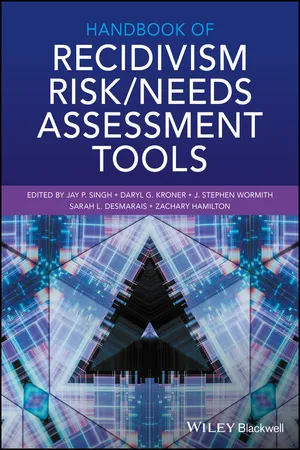
Handbook of Recidivism Risk / Needs Assessment Tools
- English
- ePUB (mobile friendly)
- Available on iOS & Android
Handbook of Recidivism Risk / Needs Assessment Tools
About This Book
Provides comprehensive coverage on recidivism risk/needs assessment tools
Correctional and healthcare professionals around the world utilize structured instruments referred to as risk/needs assessment tools to predict the likelihood that an offender will recidivate. Such tools have been found to provide accurate and reliable evaluations and are widely used to assess, manage, and monitor offenders both institutionally as well as in the community. By identifying offenders in need of different levels of intervention, examining causal risk factors, and individualizing case management plans, risk/needs assessment tools have proven invaluable in addressing the public health issue of recidivism. Recidivism Risk/Needs Assessment Tools brings together the developers of the most commonly-used risk/needs assessment tools to provide a comprehensive overview of their development, peer-reviewed research literature, and practical application.
Written by the leading professionals in the field of risk/needs assessment, the book provides chapters on: Recidivism Risk Assessment in the 21st Century; Performance of Recidivism Risk Assessment Instruments in Correctional Settings; Correctional Offender Management Profiles for Alternative Sanctions (COMPAS); the Federal Post-Conviction Risk Assessment Instrument; the Inventory of Offender Risks, Needs, and Strengths (IORNS); the Level of Service (LS) Instruments; the Ohio Risk Assessment System (ORAS); the Self-Appraisal Questionnaire (SAQ); the Service Planning Instrument (SPIn); the Static Risk Offender Needs Guide-Revised (STRONG-R); the Offender Group Reconviction Scale (OGRS); the Forensic Operationalized Therapy/Risk Evaluation System (FOTRES); the RisCanvi; and more.
- Systematically identifies currently-validated recidivism risk/needs assessment tools
- Reviews research on recidivism risk/needs assessment tools used internationally
- Each chapter presents sufficient detail to decide whether a given recidivism risk/needs assessment tool is right for your practice
Recidivism Risk/Needs Assessment Tools is ideal for correctional, probation and parole, and behavioral health professionals.
Frequently asked questions
Information
Part I
Introduction
1
Performance of Recidivism Risk Assessment Instruments in U.S. Correctional Settings*
Table of contents
- Cover
- Title Page
- Table of Contents
- Notes on Contributors
- Preface: Recidivism Risk Assessment in the 21st Century
- Part I: Introduction
- Part II: Risk/Needs Assessment in North America
- Part III: Risk/Needs Assessment Abroad
- Part IV: Conclusion
- Appendix
- Index
- End User License Agreement